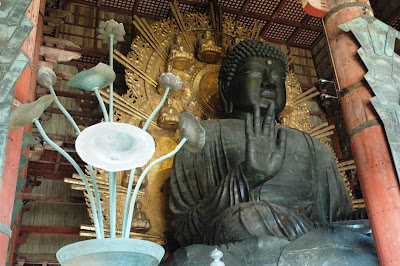Todaiji Temple is Nara's top tourist attraction, mainly because of its Daibutsu (Great Buddha), the largest bronze statue of Buddha in Japan. The Daibutsu resides in the Daibutsuden. You can see the Daibutsuden in the above picture. It's the building that looks like a samurai's helmet, the one with horns on its roof.
Here is what the Daibutsuden looks like from inside the compound. This building dates from 1709. Although it is only two-thirds the size of the original structure erected in the mid-700s, it is still the largest wooden structure in the world. Emperor Shomu, who commissioned Todaiji Temple, wanted it to serve as the headquarters of all Buddhist temples in Japan.
We wanted to see the bronze Great Buddha and everything else inside the Daibutsuden so we scrounged up 500 yen each for the privilege. "This is a lot cheaper than a taxi ride to Kinki Amibari," Mr. Keeper noted.
According to our guidebook, the Great Buddha, or Buddha Vairocana, is more than 50 feet tall and is made of 437 tons of bronze, 286 pounds of pure gold, 165 pounds of mercury, and 7 tons of vegetable wax. That's a lot of bronze. So much bronze, in fact, that completion of this statue in 751 left Japan nearly bankrupt.
This statue sits next to the Buddha. Please note the size of the wooden pillars. There is a hole in a pillar behind the Buddha which is said to be the size of Buddha's nostril. Legend has it that whoever manages to crawl through that opening will achieve enlightenment. Neither of us had a chance of squeezing through that hole but we had fun watching toddlers and infants attain instant wisdom.
These are two of the dozens of recently-enlightened little boys we met in Nara. One of us hopes Buddha happened to suggest they spend the rest of their childhoods running interference between wild deer and middle-aged gaijin women.
"What are you doing now, Ninja Lady?"
"I'm peeking through a stone lantern, making sure the coast is clear of deer before we head over to Kasuga Grand Shrine."






No comments:
Post a Comment